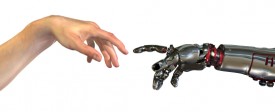
Earlier this year, I wrote about a researcher named Dr. Miguel Nicolelisat Duke University Medical Center and his work with a monkey named Aurora. Through placing implants in Aurora’s skull, Nicolelis was able to record Aurora’s motor nerve signals as she used a joystick to play a simple video game. He then used a computer algorithm to convert those signals into code to power a robotic arm. Over time, because of her brain’s ability to adapt and learn, Aurora taught herself how to control the movements of that robotic arm by just thinking about it.
What we see in Nicolelis’s work is the complex interplay of three different elements of a neural prosthetic system: hardware, software, and what has been come to be known as “wetware.”
- Hardwarerefers to the machine part of the system. This consists of the wires, computers, circuits, implants and manufactured devices that comprise the system.
- Softwarerefers to the set of instructions, data and algorithms – in other words, the set of rules – that govern the function and operation of the hardware.
- Wetwarerefers to the combination of biological elements involved in the system, generally including muscles, hormones, nerves and the brain.
Through choreographing the delicate dance between these three systemic elements, biomedical professionals are becoming more able to develop neural prosthetics that continue to improve the quality of life for any number of disabilities, substituting motor, sensory or cognitive capabilities that have been damaged as a result of injury or disease.
Today, biomedical research has given rise to any number of neural prostheses. Visual prosthetics stimulate the optic nerve to counter certain types of blindness. Spinal cord stimulators induce sensations to mask and control pain. Pacemakers work with the muscle and nerves of the heart to monitor and regulate the heartbeat and control fibrillation.
One of the most common applications of the neural prosthesis concept is in the cochlear implant. Dr. Michael Merzenich, professor emeritus and neuroscientist, was the Principal Investigator back during the development of the first cochlear implants at the University of California, San Francisco. The work showed that in as little as six months, patients were able to develop remarkable speech discrimination abilities. It was found that speech discrimination abilities improved over time due to the brain’s plastic ability to change and adapt to these new inputs.
According to the NIH’s National Institute on Deafness and Other Communications Disorders, over 59,000 adults and children have cochlear implants. Just like Aurora’s robotic arm, a cochlear implant involves the integration of hardware, software and wetware. But instead of using motor neurons to articulate robotic fingers, cochlear implants form the technological bridge between the world of sound and the ability to perceive that sound in someone whose ears cannot convert sound vibrations to a nerve impulse. While the ones we developed had a single channel, today’s devices have up to 120, which allows for better input fidelity through stimulating different parts of the auditory nerve.
Of the three elements of the neural prosthetic system, hardware, software and wetware, the only one of them that can be expected – even depended upon – to change over time is the wetware. Both because of normal development and brain plasticity, an individual’s ability to effectively use neural prosthetic will naturally change over time as the individual’s own nervous system adapts to make better use of the hardware and software.
As Dr. Nicolelis demonstrated with Aurora, wetware is an amazingly malleable apparatus. We might imagine these neural prosthetic systems as fantastically complex in terms of their hardware and software. That said, research out of the University of Washington, Seattle, has suggested that, because of brain plasticity, we may be able to use simpler algorithms in the external hardware and software, and depend upon the plasticity of the wetware to make optimal use of these devices.
In the end, we as humans, with our drive to heal and discover, seem to have a limitless ability to develop innovations to remedy our physical ills. And yet, it is the plasticity of our nervous system’s innate ability to adapt that will apparently allow us to make the most of these innovations.
For further reading:
Fallon, J. B., Irvine, D. Shepherd, R. Neural Prostheses and Brain Plasticity. J Neural Eng. 2009 December.
Moritz, C. T., Perlmutter, S. I., Ftez, E. E. Direct Control of Paralysed Muscles by Cortical Neurons. Nature. 2008 December.
Related Reading:

